GED GED Science GED Science Exam Online Training
GED GED Science Online Training
The questions for GED Science were last updated at Oct 30,2025.
- Exam Code: GED Science
- Exam Name: GED Science Exam
- Certification Provider: GED
- Latest update: Oct 30,2025
Students in a biology class were asked to construct hypotheses about the relationship between air temperature and the number of times crickets chirp per minute. They listened to a tape of crickets chirping at six different temperatures. The students counted the number of chirps per minute and recorded their results, which are shown in the table below.
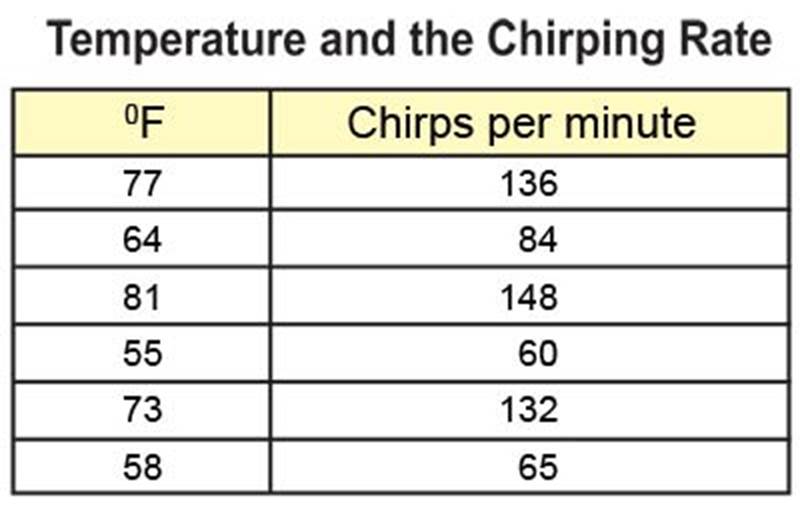
Which statement best describes the relationship between the number of chirps and the air temperature?
- A . The crickets will not chirp at 0° F.
- B . The crickets will not chirp when the temperature is above 81° F.
- C . As the temperature decreases, the number of chirps increases.
- D . As the temperature increases, the number of chirps increases.
- E . There is no relationship between the number of chirps and the temperature.
Nicotine patches are a popular smoking cessation method. Although they are effective for some people, not all nicotine patches work, and some doses work better than others. The graph below shows the effectiveness of nicotine patches for patients who participated in a 24-week study.
Based on the graph, Whatpercentage of patients receiving the 21-mg nicotine patches remained off cigarettes after six weeks?
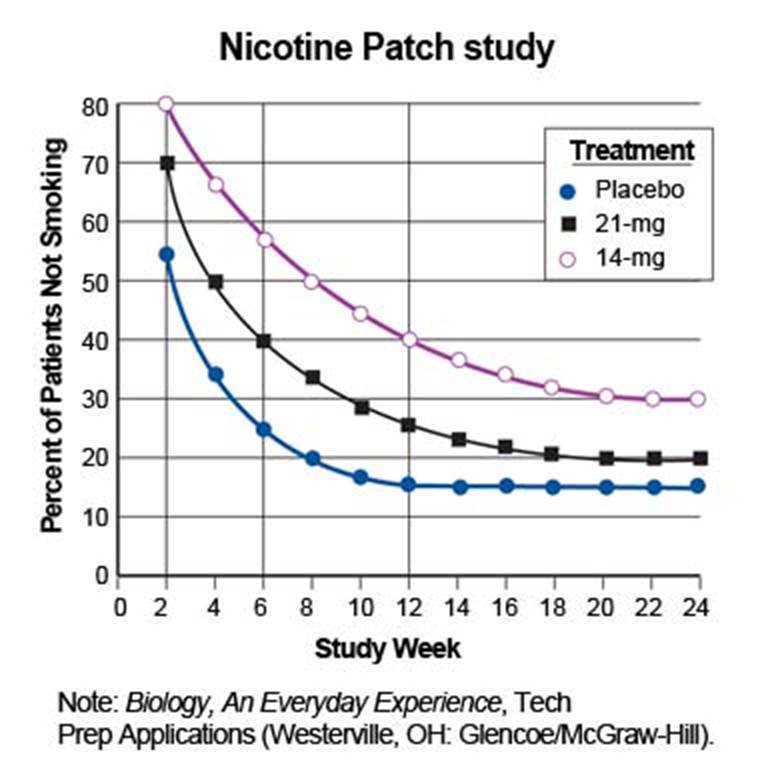
- A . 57%
- B . 40%
- C . 27%
- D . 15%
- E . 5%
Blood typing is essentially a chemical reaction that provides data so that blood may be safely transfused from one person to another. The basic objective is to avoid “clumping” that could occur in the recipient when the wrong blood type is received. These “clumps” of red blood cells could block arteries or veins affecting the blood flow to critical body organs,
like the heart or the brain. Exhibit:
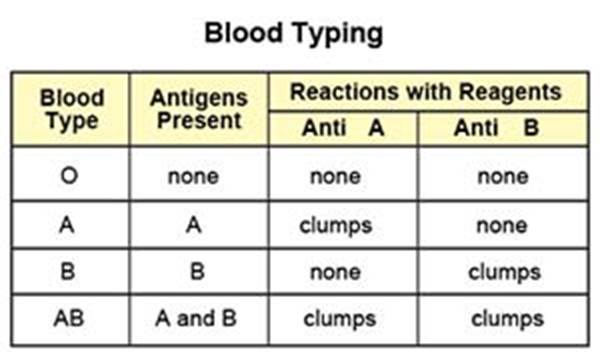
Based on the chart and the information, which blood type will not form clumps with either Anti-A reagent serum or the Anti-B reagent serum?
- A . Type A
- B . Type B
- C . Type AB
- D . Types A and B
- E . Type O
Since carbon dioxide dissolves in water to form an acid, an acid-base indicator such as bromthymol blue is used to track the acid concentration during plant photosynthesis and respiration. Bromthymol blue turns yellow in an acid solution and remains blue in a basic solution. The color change is reversible. A student used the following procedure to track carbon dioxide.
In an experiment, a student placed a solution of bromthymol blue into each of two flasks, inserted a drinking straw in each flask, and blew through the straw until the solution turned from blue to yellow. Carbon dioxide, a waste product in the student’s breath, caused the color change. The student then placed a small Elodea water plant in each flask and closed the flasks with rubber stoppers. Flask A was placed in bright sunlight, while flask B was
placed in the dark for 24 hours, as shown in the figure below.
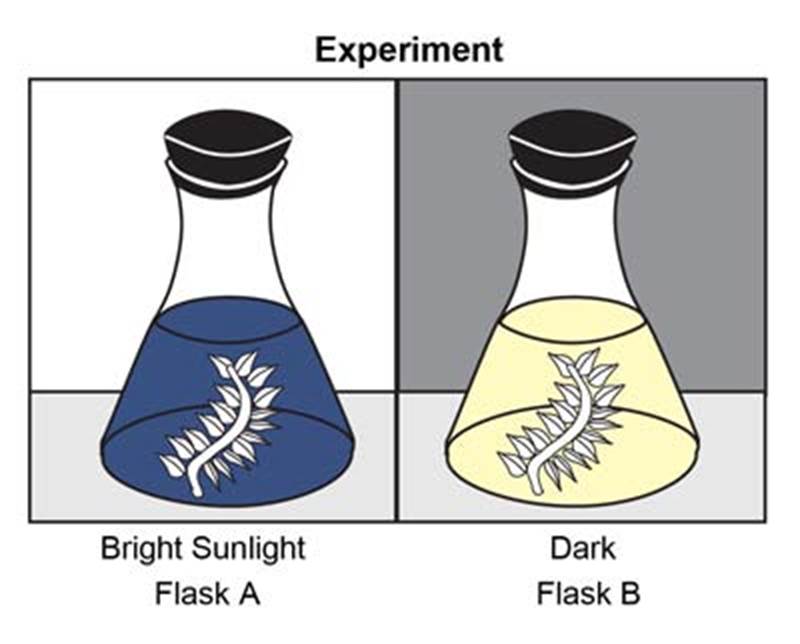
After 24 hours, the bromthymol blue in flask A had turned back to blue, while in flask B it was still yellow.
If living things use oxygen and release carbon dioxide during respiration, what is the most probable reason that the atmosphere does not become depleted of oxygen and become filled with carbon dioxide?
- A . Plants replace the oxygen in the atmosphere and use carbon dioxide during photosynthesis.
- B . The atmosphere supplies large amounts of oxygen and absorbs large amounts of carbon dioxide.
- C . Carbon dioxide in the atmosphere breaks down in sunlight to release oxygen and water.
- D . Carbon dioxide is used by many invertebrate animals in place of oxygen during respiration.
- E . Plants don’t use oxygen from the atmosphere in the dark, but they do use carbon dioxide.
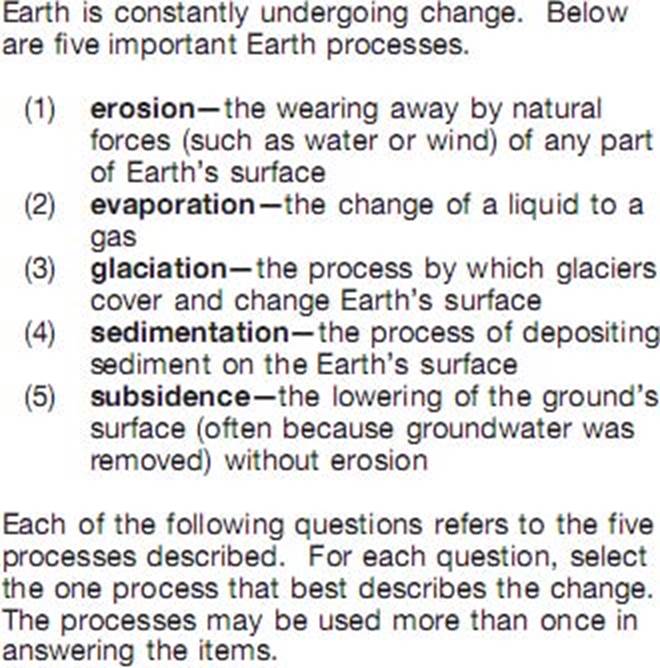
A home built on the California coast was once 150 yards from the shore. Now it is only 75 yards away.
Which process is most likely responsible for this change?
- A . erosion
- B . evaporation
- C . glaciation
- D . sedimentation
- E . subsidence
Animal populations are regulated by a variety of natural factors. Five of these factors are:
✑ competition―A struggle among rival organisms results when available resources
(for example, food or shelter) are limited. ✑ predation―Many animals pursue and eat other animals as prey. ✑ disease―In overcrowded populations, the buildup of waste products contributes to
the easy spread of disease. ✑ stress―In some populations, overcrowding can lead to hormonal disorders, which can cause abnormal behavior, thereby limiting the population. ✑ natural disaster―The occurrence of storms, floods, and earthquakes can significantly affect a population’s size.
✑ During the Middle Ages, the human population of Western Europe was severely reduced by a combination of unsanitary conditions and the abundance of flea-infested rats that spread the plague.
Based on the information provided, which of the following factors was responsible for the population reduction?
- A . competition
- B . predation
- C . disease
- D . stress
- E . natural disaster
A physical change is a change that occurs in a substance without the formation of a different substance. In a chemical change, new substances are formed.
Which situation is an example of a chemical change?
- A . burning a stack of papers
- B . melting snow
- C . boiling water
- D . breaking glass
- E . chopping wood
The nightshade family of plants includes more than 2000 species of herbs, shrubs, and small trees. Plants with edible parts include the potato, tomato, eggplant, and red pepper. Some nightshade members such as jimsonweed and belladonna contain poisonous substances. Tobacco and petunias are also in the nightshade family.
Which of the following most accurately describes the entire group of plants in the nightshade family?
- A . poisonous plants
- B . edible plants
- C . no economically important species
- D . no agriculturally important plants
- E . a large variety of species
A contour line is a line passing through points with the same altitude above sea level. A steep slope is represented by closely spaced contour lines; widely spaced contour lines show a more gradual incline.
A topographic map displays these contour lines and helps outline the shape of the landscape locating hills, cliffs, and depressions.
Based on the topographic map at the left, if a person wants to travel on level ground as much as possible, which would be the easiest path between points A and B?
Exhibit: Exhibit
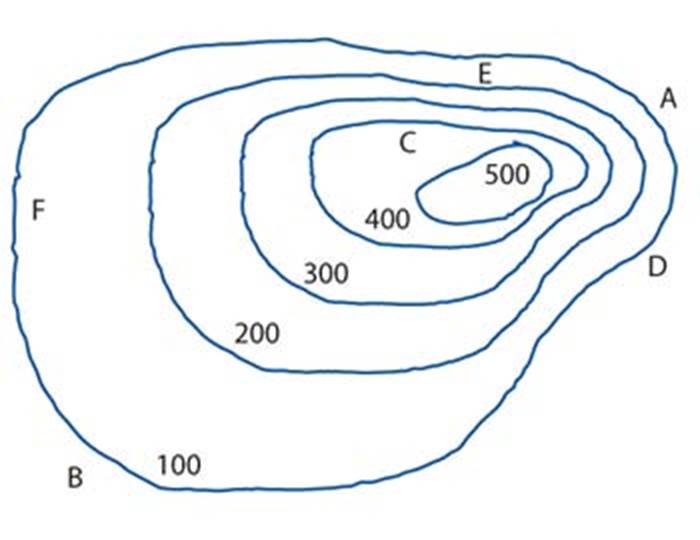
- A . A C D C C C B
- B . A C E C F C B
- C . A C C C B
- D . A C C C F C B
- E . A C F C C C B
A person who takes medication in capsular form would be ingesting materials produced by which algae?
- A . green algae
- B . brown algae
- C . golden-brown algae
- D . red algae
- E . green algae and brown algae
Latest GED Science Dumps Valid Version with 300 Q&As
Latest And Valid Q&A | Instant Download | Once Fail, Full Refund

